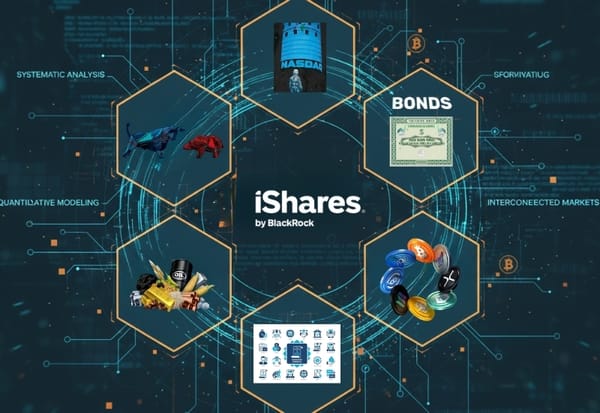NASDAQ Files Historic Proposal for Tokenized Securities Trading
Nasdaq files historic SEC proposal to enable tokenized securities trading alongside traditional stocks. This could be the biggest blockchain integration into U.S. markets yet - and XRP is positioned to benefit from the $18.9T tokenization boom. Read how this changes everything

TL;DR: Nasdaq has filed with the SEC to enable tokenized versions of stocks and ETFs to trade alongside traditional securities on its main exchange, potentially marking the most significant integration of blockchain technology into U.S. equity markets. This could create massive opportunities for XRP and the broader crypto ecosystem.
In a groundbreaking move that could reshape the future of financial markets, Nasdaq Inc. filed a proposal with the U.S. Securities and Exchange Commission on Monday to allow trading of tokenized securities on its exchange, seeking to amend rules, including the definition of a security, to allow stocks to be tokenized and traded on regulated venues.
This represents the first major attempt by a U.S. stock exchange to integrate blockchain-based settlement into the national market system, potentially opening the door for widespread adoption of tokenized assets across traditional finance.
How Nasdaq's Tokenized Trading Would Work
Under Nasdaq's proposal, securities could be traded in either traditional digital form or tokenized form, with investors able to select their preferred settlement method on a trade-by-trade basis. The system would maintain the same order entry and execution rules for both formats, ensuring no execution advantage for either approach.
The Depository Trust Corporation (DTC) would handle clearing and settlement for tokenized trades, with all shares maintaining the same identification number (CUSIP) and giving holders identical rights and benefits as traditional shares. This approach preserves existing investor protections while introducing blockchain efficiency.
Chuck Mack, Nasdaq's Senior Vice President of North American Markets, emphasized that "tokenized securities are technologically distinct from those traded today on Nasdaq's market, but under our proposal they still represent the same store of value as their traditional counterparts".
Market Impact and Timeline
U.S. investors could see the first token-settled trades of securities by the end of the third quarter of 2026, assuming the Depository Trust Company's infrastructure is in place by then. The proposal comes amid an increasingly crypto-friendly regulatory environment under the Trump administration.
The filing arrives days after the SEC unveiled its rulemaking agenda, which included a potential amendment of its rules to allow for crypto to be traded on national securities exchanges and alternative trading systems. Under new SEC chair Paul Atkins, the agency has been working to revamp cryptocurrency regulations and reduce burdensome rules.
The move aligns Nasdaq with other major financial players exploring tokenization. Companies like Coinbase have applied to offer tokenized equities, while international banks including Citi and Bank of America are actively exploring stablecoins and tokenization solutions.
Regulatory Considerations and Market Structure
As part of its proposal, Nasdaq argued it would raise the bar for tokenized securities to have "the same material rights and privileges as do traditional securities of an equivalent class". This directly addresses concerns about synthetic tokenized products that don't convey full shareholder rights.
Nasdaq emphasized that "the exchange will not treat tokenized instruments to be equivalent to their traditional counterparts if they do not convey such rights, in whole or in material part", setting a high standard for legitimate tokenized securities.
The proposal also tackles a growing problem in the market: companies aren't in control when their shares are tokenized by outsiders, with Nasdaq noting that "tokenizing securities should not occur in a manner that deprives issuers of their ability to determine where and how their shares trade".
XRP and Ripple: Positioning for the Tokenized Future
This development could be particularly significant for XRP and Ripple's ecosystem. A recent report by Ripple and Boston Consulting Group projects that tokenization of real-world assets will grow from $0.6 trillion in 2025 to $18.9 trillion by 2033, representing a 53% compound annual growth rate.
Ripple has been strategically positioning itself in the tokenization space. The XRP Ledger's 2025 roadmap focuses on institutional DeFi and compliance upgrades, with features like Multi-Purpose Token (MPT) that allows institutions to tokenize and trade bonds, real-world assets, and structured financial products.
The XRPL's compliance-ready infrastructure includes support for Decentralized Identifiers (DIDs) and credentials that enable KYC and AML compliance—crucial for institutional adoption. Guggenheim's Digital Commercial Paper has already leveraged these features on the XRP Ledger.
Price Implications for XRP
While tokenization growth doesn't guarantee immediate price impacts, the long-term potential is substantial. According to analysis using projections from BlackRock, Citigroup, Boston Consulting Group, and the World Economic Forum, if XRP captures just 1% of a $100 trillion tokenized economy as a settlement layer, its market cap would need to reach $1 trillion.
Institutional interest and adoption, including tokenized treasuries and potential spot ETF approval, could boost XRP price toward $10.00 by the end of 2025, though this remains speculative and dependent on multiple factors aligning.
Currently, tokenized real-world assets on-chain carry a value of $26.44 billion, with XRPL accounting for just $302.4 million or about 1.1% of the market. However, Nasdaq's move could legitimize tokenization and accelerate institutional adoption across all blockchain platforms.
Looking Ahead
Nasdaq's filing represents more than a technological upgrade—it signals that blockchain-based assets are moving from experimental side projects to core components of the national market system. Tal Cohen, President of Nasdaq, commented that "the integration of tokenization and blockchain technology alongside traditional market infrastructure presents an exciting leap forward for the global financial system".
The proposal must undergo SEC review and a public comment period before implementation. If approved, it could establish the baseline for how tokenized assets are traded globally, potentially forcing competitors to follow suit and accelerating the adoption of blockchain technology across traditional finance.
For the crypto industry, particularly platforms like XRP that are positioned for institutional tokenization use cases, Nasdaq's move validates the long-term vision of a tokenized financial system. Whether XRP can capitalize on this opportunity will depend on continued technological development, regulatory clarity, and competitive positioning in the rapidly evolving tokenization landscape.



